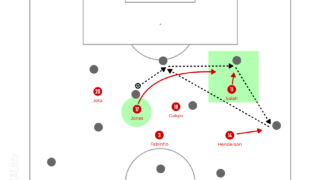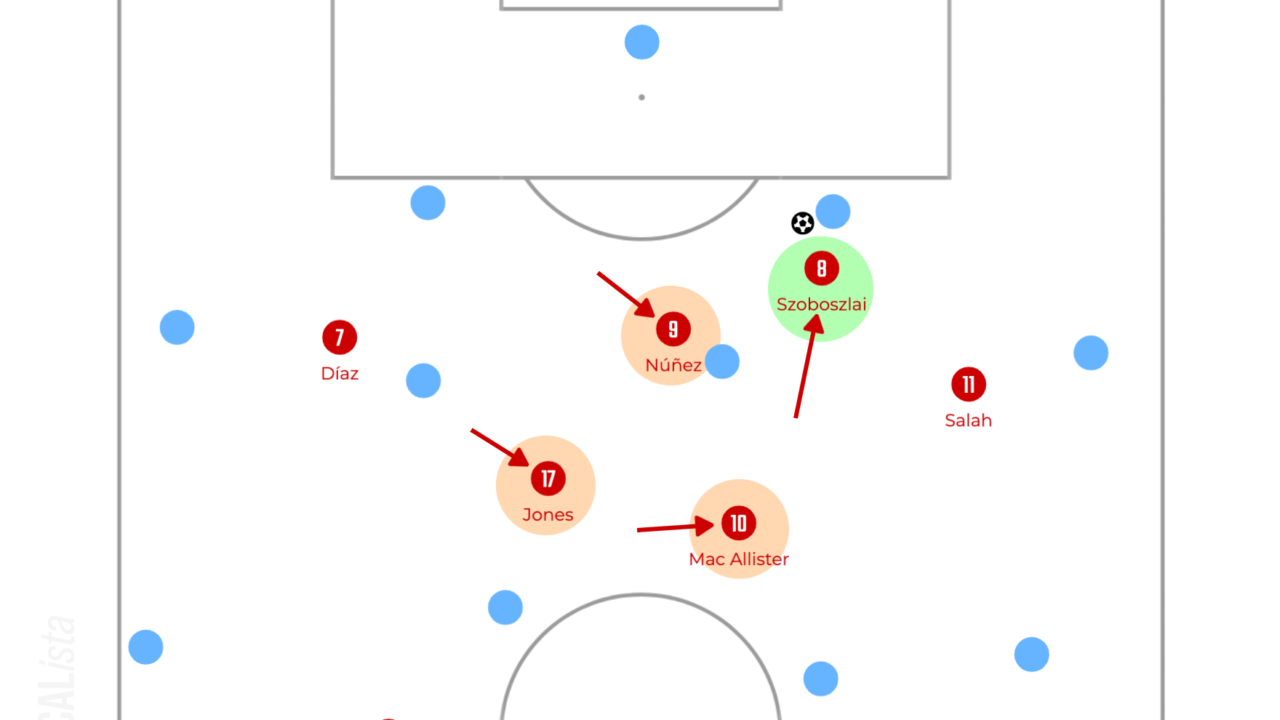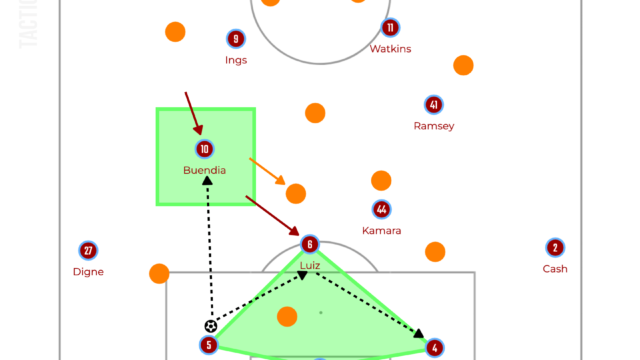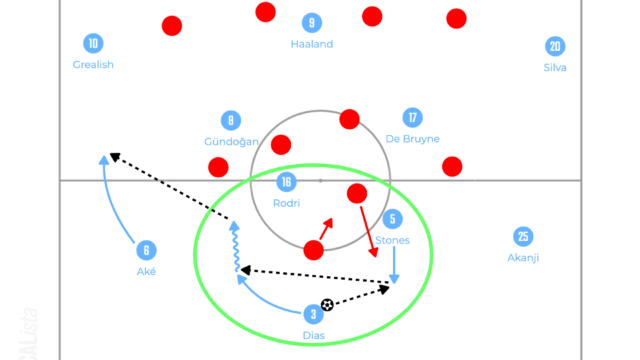Overview
Fabinho, Jordan Henderson, Naby Keïta, Alex Oxlade-Chamberlain and James Milner have left the club and Dominik Szoboszlai, Alexis Mac Allister, Ryan Gravenberch and Wataru Endo have been signed to replace them. The midfield of Liverpool is completely being rebuilt now. Too many changes in the squad sometimes cost some points until the new team starts to work well, but Liverpool have managed to win five games and lost only once in eight league games. Thankfully, the back line and attackers have hardly changed, so the only matter is how quickly the new midfielders can adapt the way of Liverpool and the easy six games of the group stage in the UEFA Europa League would help them to give more minutes to the new players.
In possession, Trent Alexander-Arnold had been positioned in the midfield from last season and played an important role to distribute the ball everywhere. Additionally, Szoboszlai, who is one of the quickest players to adapt the team, has played the same role with his accuracy of kicking the ball during the period when Alexander-Arnold was not available. More crucially, Darwin Núñez is now fully flourishing. Not only scoring goals but also he helps the team when they need to play long by holding the ball and starting a fast attack.
However, out of possession, they are not as good as before due to their lack of natural defensive midfielders. Mac Allister, who should play higher up the pitch, is now playing as a pivot, but he is not good at winning the duels to win the ball. Endo is a natural pivot, but he struggles with the zonal pressing style as he tends to follow the opponent too much and also he needs a help of Alexander-Arnold or Szoboszlai in possession.
The earlier the new midfielders adapt the team, the more likely they would challenge the title. In this article, both tactics in and out of possession are going to be analysed in detail with mainly focusing on the new midfield. I hope you will enjoy this article.
If you are interested in the tactics last season, there is an analysis here.

Build up
From goal kicks or when playing out from the goalkeeper, the shape has been already tweaked this season. At the beginning, Alexander-Arnold was in the middle and Alisson was a part of the back four. From around the third game of the season against Newcastle, Alexander-Arnold started to stay in the right flank and Szoboszlai dropped next to Mac Allister to form the double pivot. This might be because of the solution against the front three of Newcastle, but even after that, the right fullback remains outside when playing out from the back.
They are willing to play long under the intense pressure, but one of their main routes is finding an 8 drifting outside, mainly Szoboszlai or Curtis Jones. Thanks to the wingers pinning the opposition back line, after a fullback drags the opposition winger, there is huge space between the opposition fullback and the opposition winger.

In addition to this, the different starting positions of Szoboszlai and Jones or Cody Gakpo provides different routes. Thanks to the high position of Jones or Gakpo, they can often receive the ball behind the opposition midfield line, but Szoboszlai is deep and next to Mac Allister, so one of the opposition midfielders can tightly mark him and track the movement. However, this can open a passing lane from the right fullback to Mac Allister.

One of their weaknesses is, it is surprising though, Virgil van Dijk. He often plays too simply, and it costed goals conceded against Bournemouth and Brighton. As he hardly carries the ball or makes something happen before a pass, the player who receives the ball is often in trouble. It is so predictable that the opponents can anticipate where the ball will be played, so it is possible for them to apply tighter pressure on the ball. Unlike him, Joël Matip and Ibrahima Konaté can carry the ball forwards to drag the opponents out of their positions before they play a pass. Therefore, the pass can break the opposition line and the player who receives the ball can play more comfortably.
When they need to play long, especially Núñez is extremely good at being a target. He can hold the ball up front and become the first player to start a fast attack. He is also comfortable with carrying the ball forwards, which makes him the first player to begin the fast attack and lets the other attackers run forwards.
In the midfield, the right fullback Alexander-Arnold finally inverts and pushes Szoboszlai higher. However, during the period when he was out, Joe Gomez tended to be in the right flank and Szoboszlai stayed deeper to distribute the ball like Alexander-Arnold.

Even in the midfield, their objective is similar to when playing out from the back, which is playing around and breaking the opposition line in wide areas. Since the 8s often moves outside in the own half, the 8s and wingers swaps each position frequently. In addition to this, Alexander-Arnold moves inside, which makes the triangle in the right flank extremely flexible. The importance of the flexibility of the triangles is strongly talked by the assistant manager, Pep Lijnders in his book ‘Intensity’. This book is extremely insightful, so even if you are not a Liverpool fan, this book is so recommendable to understand their tactics, game plans or Klopp’s motivational talks in detail.
Among the triangle, they share so many patterns to play, but the main principle is playing behind quickly. For example, as soon as Mohamed Salah receives the ball by the touchline, Szoboszlai makes a run through the channel to receive a through pass from the winger.

Thanks to the flexibility in the right flank, it can be Salah to make a run or Alexander-Arnold to play in behind. However, in terms of the tendency, Szoboszlai often makes a run in behind in the right flank.
In the left side, the left winger is often picked up by Alexander-Arnold’s diagonal switch and it is possible to progress into the final third. The famous diagonal switch can be played by Szoboszlai, and this is the characteristic of Liverpool in the midfield.
In terms of playing through the middle, it highly depends on the individuals. Diogo Jota and Gakpo are the main players to drop to receive the ball in between the lines. As soon as one of the attackers receives the ball and turns forwards, other wingers or striker makes a forwards run and the player who has the ball in between the lines quickly plays in behind, even with a first-time pass. It is not always successful, but even though the pass is intercepted, the players around the ball quickly counter-press and create a transition moment which is comfortable for them.
Final Third Attacking
In the final third, since their objective in building up is playing in behind as quick as possible, they want to penetrate into the box and finish quickly with the attackers up front. The situation can be created by playing a counterattack, playing over quickly or switching the ball diagonally. After the diagonal switch, the winger on the ball takes on the opposition fullback and the opposite side players attack the box, including the fullback especially Andrew Robertson.
Against a deep defensive block, of course there are some differences depending on individuals, but as it was mentioned before a lot, the triangles are extremely important.

The wingers such as Salah and Luis Díaz love to cut inside and the other players offer various support. In the left side, Robertson often offers a passing lane to play through by making a run in behind with overlapping or underlapping. To balance the triangle, Jones often drops to back the others, but he is also good at attacking the box. In the right side, like in the midfield, Szoboszlai is the first player to support Salah by making a run in behind or drifting outside. In addition to this, as soon as finding a gap in the opposition defensive block, Alexander-Arnold makes a late run to be the third man of the triangle.
Of course, if Jota or Gakpo play in the left side, there is another option to play through the middle as they are good at receiving the ball in between the lines, so Jones tends to drop back and Robertson positions himself higher more frequently. Therefore, Liverpool’s attacking ways highly depend on the individuals, but there is a solid structure which keeps the team organised.
Overall, in possession, the wide triangle is extremely important for them to find a spare player when playing out and break the opposition defensive block down. It depends on the individuals if they can use the space between the lines effectively, but they can create so many chances from wide areas by the winger’s dribbles or fullback’s crosses.
Pressing
When pressing high, which is the biggest strength of Klopp’s men, they have made slight changes. Basically, they prioritise to press as a team, so they dropped the pressing line while keeping the back line high to keep the compactness of the team. They allow the opposition centre backs to possess the ball beyond the 18-yard line and the striker and wingers focus on preventing them from playing to the opposition fullbacks or defensive midfielders.

The pressing trigger is often pulled by either of the 8s this season. During the moment when the opposition centre backs pass each other, one of the 8s seeks the moment to step out and apply pressure on the ball and the striker mainly focuses on screening the passing lane to the opposition defensive midfielders.

In case they prioritise to prevent them from playing through, the striker or other midfielders shuffles diagonally backwards to close the space. The timing of applying tight pressure on the opponents around the ball is often when the opposition centre back plays to the opposition fullback. When the opposition keeps the ball between the opposition centre backs and goalkeeper, it is difficult to press because they can play either side. However, as soon as they play to the outside, they accelerate to mark the opponents around the ball tightly.

When they apply tight pressure around the ball, all players shuffle across and even the ball side centre back leaves his position to mark the opponent who cannot be marked by the defensive midfielder. This season, except for transition situations, they try to close the space in the middle first and then force them to play outside to lock them in with the compact shape.
However, one of their weaknesses is the absence of the defensive midfielder who can win the ball like Fabinho. After forcing the opposition fullback on the ball to play through, the ball needs to be regained by the defensive midfielder or defenders. However, when the opponent holds the ball, Mac Allister cannot win the duels to regain the possession as many times as Fabinho did a few years ago. When pressing high, it is important for the players up front to apply pressure and force the opposition to play a difficult pass and also for the defensive midfielders and defenders to intercept it or regain the possession. However, if they cannot regain the ball, the pressing cannot work well.
One of their solutions is keeping the compactness. It helps them to secure the second balls and apply tight pressure on the ball quickly in between the lines so that they do not rely on the individual quality of the defensive midfielder. However, both 8s often stays higher, which forces Mac Allister to cover huge space between the lines. Until this problem is solved, it will be difficult for Klopp to press higher.
Against the opposition goal kicks, Klopp tweaks the system little bit. Salah steps up next to Núñez and the shape becomes a 4-4-2. This helps to apply pressure on the opposition centre back compared with a 4-1-4-1 because either of Salah or Núñez is closer to the opposition centre back on the ball.

In the situation of the opposition goal kicks, it is possible for them to set their shape and also it is so easy to anticipate when the ball is played, so unlike high press in open play, they can start to apply pressure much higher as soon as the ball is played.
Overall, this season they hardly let the wingers press the opposition centre backs from the outside. They occasionally do, but it is mainly a transitional situation. The possible reason would be that they do not want to get the fullbacks to leave their positions to cover the space behind the wingers. This is the main weakness of last season and the opposition played in behind quickly and attacked against the back three without the ball side fullback. In addition to the problem of the defensive midfielder, this is another reason of becoming more and more collective and compact when pressing this season.
Final Third Defending
In the final third, it is common that the centre backs stay in the middle to deal with crosses and defend the goal in the middle. Liverpool’s centre backs do this if there is no opponent in the half lane, but usually the back line keeps shuffling across in the final third. The objective is trying to apply tight pressure around the ball and preventing crosses from even being delivered. If it is successful, that would be the best, but this aggressive approach contains some risks.
In addition to the centre backs, the defensive midfielder also shuffles across the pitch with leaving the space in the middle. Therefore, only the opposite side centre back, fullback and 8 can defend against crosses.

One of the weaknesses caused by the approach is the lack of protection of the back post area. Since there are only two defenders in front of the goal, so the opposite side fullback needs to come more centrally, which opens the space around the back post. Considering they adopt zonal defending, the problem will not be the number of players, but the size of the space. If there are three defenders in front of the goal, the size of space which one of them needs to cover will be smaller, but defending with two players is a possible weakness for them.
Additionally, as even the defensive midfielder leaves the space in the middle, the opposite side 8 must come back to fill the space in front of the back line, but often it delays. Therefore, cut backs become extremely effective against Liverpool.
However, if they can win the ball in a wide area before the opposition delivers a cross, that turns into one of their biggest chances. As soon as they win the ball, if they can find an attacker up front, both wingers sprint to overlap him and a chance of playing a counterattack occurs. Even if they need to clear the ball roughly in behind, their attackers will chase it and win the second balls or at least gain yards. Therefore, even though the defensive structure in front of the goal has a risk, they can be rewarded a huge opportunity if they can win the ball.
Overall, the pressing line has dropped, but it does not mean they became passive. They have some problems which cannot be covered by the individuals, so they just became more collective. However, to be what they used to be, the problem of the defensive midfielder needs to be solved. Mac Allister becomes stronger or Endo adapts how to defend in the collective way, these are the options. Thank you for reading. I hope you enjoyed this article.



